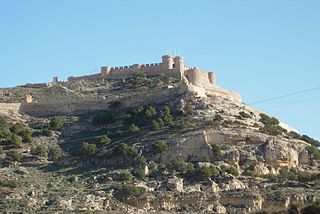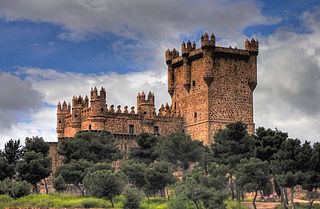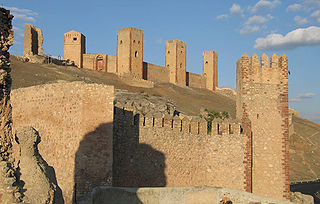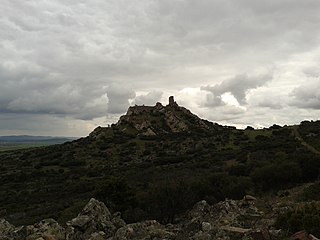 W
WThe castle of Alcalá del Júcar is of Almohad origin, located in the town of Alcalá del Júcar, in the province of Albacete, Spain, above the gorge of the Júcar river.
 W
WThe Alcázar of Toledo is a stone fortification located in the highest part of Toledo, Spain. Most of the alcázar was rebuilt, or restored, between 1939 and 1957 after the Siege of the Alcázar during the Spanish Civil War.
 W
WCalatrava la Nueva is a medieval castle and convent found on the peak of Alacranejo, within the municipality of Aldea del Rey, near Almagro, in the province of Ciudad Real, Spain.
 W
WCalatrava la Vieja is a medieval site and original nucleus of the Order of Calatrava. It is now part of the Archaeological Parks of the Community of Castile-La Mancha. Situated at Carrión de Calatrava, Calatrava during the High Middle Ages was the only important city in the Guadiana River valley. It thus guarded the roads to Cordova and Toledo.
 W
WThe Castle of Alarcón forms part of the fortifications built around the town of Alarcón in Cuenca, Spain. The fortress is composed of a walled enclosure, which houses the heart of the population and the castle proper, and of five exterior towers, separate and strategically placed.
 W
WThe Castle of Almansa is a castle located in Almansa, Spain. It was declared Bien de Interés Cultural in 1921.
 W
WThe Castle of Anguix is a castle located in Sayatón, Spain. It was declared Bien de Interés Cultural in 1992.
 W
WThe Castle of Atienza is a castle located in Atienza, Spain. It was declared Bien de Interés Cultural in 1931. Standing high on a rock, it can be seen from miles around. The castle frequently changed hands between the Muslims and the European Christians until it was finally taken by Alfonso VI in 1085.
 W
WThe Castle of Barcience is castle in Barcience, Spain. It was a stronghold of the House of Silva.
 W
WThe Castillo de Belmonte is a medieval castle on the hill of San Cristobal, just outside the village of Belmonte in the southwest of the province of Cuenca in Spain. It was declared a historic monument within the National Artistic Treasury by a decree of 3 June 1931 and is now a Bien de Interés Cultural.
 W
WThe Castle of Chinchilla is a castle located in Chinchilla de Monte-Aragón, Spain. It was declared Bien de Interés Cultural in 1931.
 W
WThe Castle of Guadamur is castle in Guadamur, Spain.
 W
WThe Castle of La Muela is a castle in Consuegra, Spain. It was a stronghold of the Knights Hospitaller during the Middle Ages.
 W
WThe Castle of Palazuelos is a castle located in Palazuelos Sigüenza, Spain. It was declared Bien de Interés Cultural in 1951.
 W
WThe Castle of Pelegrina is a castle located in Sigüenza, Spain. It was declared Bien de Interés Cultural in 1949.
 W
WThe Castle of Pioz is a castle located in Pioz, Spain. It was declared Bien de Interés Cultural in 1990.
 W
WThe Castle of Riba de Santiuste is a castle located in Sigüenza, Spain. It was declared Bien de Interés Cultural in 1992. The castle was rebuilt twice: in 15th century for the first time and in 19th century after it had been partially destroyed.
 W
WThe Castle of the Bishops of Sigüenza is located in Sigüenza in the Province of Guadalajara in central Spain. With foundations dating back to the 5th century, it was extended by the Moors and retaken for the Christians by Bernard of Agen in 1123.
 W
WThe Castle of Torija is a castle located in Torija, Spain. It was declared Bien de Interés Cultural in 1931. First built by the Knights Templar in the 11th century, today it serves as the headquarters of the Centro de Interpretación Turística de la Provincia de Guadalajara, the regional tourism authority.
 W
WThe Castle of Zafra is a 12th-century castle in the municipality of Campillo de Dueñas, in Guadalajara, Spain. Built in the late 12th or early 13th century on a sandstone outcrop in the Sierra de Caldereros, it stands on the site of a former Visigothic and Moorish fortification that fell into Christian hands in 1129. It had considerable strategic importance as a virtually impregnable defensive work on the border between Christian and Muslim-ruled territory.
 W
WThe Castle of Zorita de los Canes-Alcazaba de Zorita is a castle located in Zorita de los Canes, Spain. It was declared Bien de Interés Cultural in 1931.
 W
WEstrella Castle is a castle in Montiel, province of Ciudad Real, Spain. It was built by the Arabs in the 9th century and was renovated in 1226, after being reconquered by the Christians.
 W
WThe Castle of Jadraque is a castle in the municipality of Jadraque, Castile-La Mancha, Spain. It sits on a hill commanding the plain of the Henares river. It is sometimes called "Castle of Cid" as it is mentioned in the poem Cantar del Mio Cid.
 W
WThe Castle of Molina de Aragón is a fortification in Molina de Aragón, Castile-La Mancha, Spain. It was declared Bien de Interés Cultural in 1931.
 W
WPalazuelos is a village in the Spanish province of Guadalajara, in the north of the autonomous community of Castilla-La Mancha. Presently it is included in the city limits of Sigüenza, due to its small population.
 W
WSalvatierra Castle is a fortification near Calzada de Calatrava in the south of the province of Ciudad Real, Castilla-La Mancha in Spain. It is located on a small hillock at the foot of the volcanic Mount Atalaya, about 5 kilometres (3.1 mi) from Calzada de Calatrava.
 W
WThe Castle of San Servando is a medieval castle in Toledo, Spain, near the Tagus River. It was begun as a monastery, occupied first by monks and later by the Knights Templar.